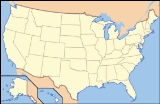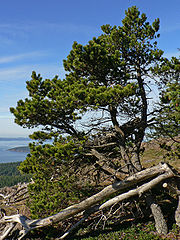
Anacortes Community Forest Lands
Encyclopedia
Anacortes Community Forest Lands (ACFL) consists of mostly forested lands surrounding and adjoining Little Cranberry
, Heart, and Whistle Lake
s on Fidalgo Island
, west and south of Anacortes, Washington
. Its highest point is Mount Erie
, the highest point on the island at 1273 feet (388 m). Sugarloaf, 1,044 feet (318 m) and 0.6 miles (1.0 km) north of Mount Erie, is its second highest peak. As well as the aforementioned lakes, ACFL contains a number of smaller lakes, ponds and wetlands.
ACFL originated in the August 2, 1919 purchase by the city of Washington Power, Light and Water Company equipment and lands for $135,000.
Prior to 1989, the forest was logged for the revenue that it produced. In the late 1980s, the forest produced little or no net income and a community organization, Friends of the Forest, was formed to oppose logging. Subsequently, a survey by the Parks Department indicated that the community favored non-forestry uses of those lands, and a study showed that the forest trails were highly valued for recreational use. In 1990, the Forest Endowment Fund was started. On April 15, 1991, the City Council ended logging, except to remove downed or dangerous trees, from the permitted uses of the forest. In 1998, a Conservation Easement Program (CEP) was adopted by the city council as a means of funding ACFL and preserving the forest. Contributions to the CEP preserve the forest at a rate of $1000 per acre. The plan is monitored by Skagit Land Trust. As of mid-2007, over $1.5 million had been contributed and 1500 acres (6.1 km²) was preserved.
 The forest includes lakes, bogs and wetlands, low mountains and rocky cliffs. Most of the forest has been logged once or twice, but a notable grove of low-elevation old growth forest remains. The upper story is dominated by Pinaceae
The forest includes lakes, bogs and wetlands, low mountains and rocky cliffs. Most of the forest has been logged once or twice, but a notable grove of low-elevation old growth forest remains. The upper story is dominated by Pinaceae
(Pine Family) including Pseudotsuga menziesii (Douglas-fir), Tsuga heterophylla (Western Hemlock), Pinus contorta (Shore Pine), and Abies grandis (Grand Fir), as well as Acer macrophyllum (Bigleaf Maple), Arbutus menziesii (Pacific Madrone), and Alnus rubra (Red Alder). Important understory species are Gaultheria shallon (Salal) and Acer circinatum (Vine Maple).
Little Cranberry Lake
Little Cranberry Lake is located within Anacortes Community Forest Lands on Fidalgo Island in the northwestern corner of the U.S. state of Washington. The lake is deepened by a dam on the northern end which was constructed in the 1930s...
, Heart, and Whistle Lake
Whistle lake
Whistle Lake is a small lake located within city limits in Anacortes Community Forest Lands southeast of central Anacortes, Washington. Though not directly accessible by vehicle, Whistle Lake attracts thousands of visitors each year. The lake may be reached by driving to the trailhead off Whistle...
s on Fidalgo Island
Fidalgo Island
Fidalgo Island is an island in Skagit County, Washington, located about north of Seattle. To the east, it is separated from the mainland by the Swinomish Channel, and from Whidbey Island to the south by Deception Pass...
, west and south of Anacortes, Washington
Anacortes, Washington
Anacortes is a city in Skagit County, Washington, United States. The name "Anacortes" is a consolidation of the name Anna Curtis, who was the wife of early Fidalgo Island settler Amos Bowman. Anacortes' population was 15,778 at the time of the 2010 census...
. Its highest point is Mount Erie
Mount Erie (Washington)
Mount Erie is a mountain in Skagit County, Washington. The park land is owned and operated by the city of Anacortes and is located in the south of the Anacortes Community Forest Lands....
, the highest point on the island at 1273 feet (388 m). Sugarloaf, 1,044 feet (318 m) and 0.6 miles (1.0 km) north of Mount Erie, is its second highest peak. As well as the aforementioned lakes, ACFL contains a number of smaller lakes, ponds and wetlands.
ACFL originated in the August 2, 1919 purchase by the city of Washington Power, Light and Water Company equipment and lands for $135,000.
Prior to 1989, the forest was logged for the revenue that it produced. In the late 1980s, the forest produced little or no net income and a community organization, Friends of the Forest, was formed to oppose logging. Subsequently, a survey by the Parks Department indicated that the community favored non-forestry uses of those lands, and a study showed that the forest trails were highly valued for recreational use. In 1990, the Forest Endowment Fund was started. On April 15, 1991, the City Council ended logging, except to remove downed or dangerous trees, from the permitted uses of the forest. In 1998, a Conservation Easement Program (CEP) was adopted by the city council as a means of funding ACFL and preserving the forest. Contributions to the CEP preserve the forest at a rate of $1000 per acre. The plan is monitored by Skagit Land Trust. As of mid-2007, over $1.5 million had been contributed and 1500 acres (6.1 km²) was preserved.

Pinaceae
Pinaceae are trees or shrubs, including many of the well-known conifers of commercial importance such as cedars, firs, hemlocks, larches, pines and spruces. The family is included in the order Pinales, formerly known as Coniferales. Pinaceae are supported as monophyletic by its protein-type sieve...
(Pine Family) including Pseudotsuga menziesii (Douglas-fir), Tsuga heterophylla (Western Hemlock), Pinus contorta (Shore Pine), and Abies grandis (Grand Fir), as well as Acer macrophyllum (Bigleaf Maple), Arbutus menziesii (Pacific Madrone), and Alnus rubra (Red Alder). Important understory species are Gaultheria shallon (Salal) and Acer circinatum (Vine Maple).

